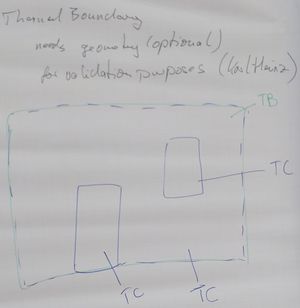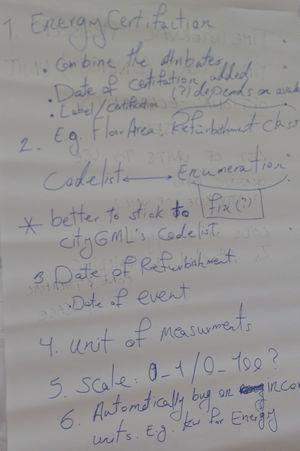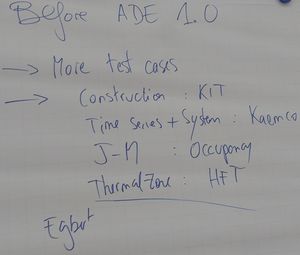Difference between revisions of "2015 Minutes of the Workshop"
| Line 91: | Line 91: | ||
|- | |- | ||
|} | |} | ||
| + | <br/> | ||
=== Presentations and Minutes === | === Presentations and Minutes === | ||
Revision as of 11:10, 10 December 2015
4th Workshop CityGML EnergyADE - Munich (Germany), 30th of November and 1st of December 2015
- Host: TU Munich, Germany
Participant contacts
| Name | Organisation | Country | |
|---|---|---|---|
| Giorgio Agugiaro | AIT | Austria | giorgio.agugiaro@ait.ac.at |
| Jean-Marie Bahu | EIFER | Germany | bahu@eifer.org |
| Joachim Benner | KIT IAI | Germany | joachim.benner@kit.edu |
| Marcel Bruse | HFT | Germany | marcel.bruse@hft-stuttgart.de |
| Mark-Alexander Brünthen | RWTH Aachen University | Germany | bruentjen@e3d.rwth-aachen.de |
| Egbert Casper | CITIS / SIG3D | Germany | egbert.casper@hft-stuttgart.de |
| Silvia Coccolo | EPFL | Switzerland | silvia.coccolo@epfl.ch |
| Piergiorgio Cipriano | Sinergis | Italy | piergiorgio.cipriano@sinergis.it |
| Volker Coors | HFT Stuttgart | Germany | volker.coors@hft-stuttgart.de |
| Mostafa Elfouly | TU München | Germany | mostafa.elfouly@tum.de |
| Christian Fliegner | RWTH Aachen University | Germany | fliegner@e3d.rwth-aachen.de |
| Karl-Heinz Häfele | KIT | Germany | karl-heinz.haefele@kit.edu |
| Marcelo Hidalgo | HCU | Germany | marcelo.hidalgo@hcu-hamburg.de |
| Patrik Holcik | AIT | Austria | e0509423@student.tuwien.ac.at |
| Jérôme Kämpf | EPFL/kaemco | Switzerland | jerome.kaempf@epfl.ch |
| Volker Kraut | MOSS | Germany | vkraut@moss.de |
| Thomas H. Kolbe | TU München | Germany | Thomas.Kolbe@tum.de |
| Moritz Lauster | RWTH Aachen University, E.ON Energy Research Center | Germany | mlauster@eonerc.rwth-aachen.de |
| Alessio Mastrucci | Research Institute Tudor | Luxemburg | alessio.mastrucci@tudor.lu |
| Alexandru Nichersu | EIFER | Germany | nichersu@eifer.org |
| Romain Nouvel | HFT Stuttgart | Germany | romain.nouvel@hft-stuttgart.de |
| Olivier Tournaire | CSTB | France | olivier.tournaire@cstb.fr |
| Athina Trakas | OGC | x | atrakas@opengeospatial.org |
| Klaus Viebig | Manufuture-BW, VBMation | Germany | klaus-viebig@t-online.de |
| Parag Wate | HFT Stuttgart | Germany | parag.wate@hft-stuttgart.de |
| Kunpeng Wang | AIT | Austria | Kunpeng.Wang@ait.ac.at |
| Maryam Zirak | HFT Stuttgart | Germany | maryamzirak@gmail.com |
Action Items (Dec. 2015 - May 2016)
| WHAT | WHO | WHEN |
|---|---|---|
| Finish the XML sample started during the workshop and lay them on the Github Repository | XML Team, with support of WG leaders | December 2015
|
| Discuss and fix latest Requests of Changes identified during the meeting | ALL | December 2015
|
| Update Wiki, deleting private page, and expliciting how to join the Energy ADE development in the main page. Create mailing lists | Egbert and Romain | December 2015
|
| Integrate the parameter definitions (from the documentation table) in the XML Scheme | XML Team | January 2016
|
| Write the Guidelines of the Energy ADE 0.6 (Guidelines_EnergyADE.md file in the Github Repository, including main concepts, definitions, illustrations and some XML examples. | Each WG | January 2016
|
| Release new version Energy ADE 0.6, including XML Scheme and Guidelines. | XML Team | January 2016
|
| Harmonize Time Series and Schedules of Energy ADE 0.6 with the CityGML 3.0/Dynamics development | Romain and Jean-Marie | January 2015
|
| Add new XML sample on the Github Repository based on the new Energy ADE v0.6 | KIT: Building sample and construction / Kaemco: Time series and System / Occupancy: EIFER / Thermal zone: HFT | March 2015
|
| Get new active participants to the WG | ALL | Always
|
| Include the dissemination materials (e.g. papers, presentations and posters) in the wiki: http://en.wiki.energy.sig3d.org/index.php?title=Main_Page&action=edit§ion=4 | ALL | Always
|
Presentations and Minutes
TOP 1: Welcome Address from the organisersProf. Thomas H. Kolbe (TU Munich) Presentation: Structuring Information Framework Current research projects taking place at TUM that are closely related to EnergyADE development:
|
TOP 2: Dissemination activities
All this dissemination information must be updated on the public wiki. The private part of the wiki is not useful anymore (all development process is centralized on the GitHub) and can be deleted. ACTION (ALL) Include the latest dissemination materials (e.g. papers, presentations and posters) and attended conferences in the wiki: http://en.wiki.energy.sig3d.org/index.php?title=Main_Page&action=edit§ion=4
ACTION (E. Casper) Make the Wiki fully public. Delete the community portal and forum
|
TOP 3: GitHub Use: XML Schema, Requests of Change and GuidelinesOlivier presented how to use the issue. Basically, there are some "developers" (TC comittee + WG leaders) and "users" rights (all others). Everybody can create and comment issues, and write in the guidelines. Developers may set the labels and Milestones. Process of Issue / request of Change
Guidelines GitHub open or private?
Cons:
A vote has been held with 20 Yes's and 1 No. It has been decided to make the Wiki fully public, with a clear link to the Github platform which remain for the moment private. Interested users is to contact Olivier Tournaire (or one of the development committee) to get an access for the Github. ACTION (Olivier Tournaire): Check if we can open the WGs without the development branch on the GitHub
ACTION (development committee): Olivier Tournaire (or someone from the development committee) may provide a tutorial for using the Github
ACTION (WGs): Contribute to the Guidelines on the GitHub
|
TOP 4: Work realised in WG OccupancyJean-Marie Bahu & Piergiorgio Cipriano (EIFER, Sinergis) Presentation: EnergyADE Occupancy Jean-Marie & Piergiorgio discussed the organisation of the WG, activites, request of changes for the EnergyADE v0.6, and what they have tackled within the last 6 months. Raised Issues:
IFC specifications are available online ACTION (KIT): Send link schema for OBXML to Occupancy WG
ACTION (KIT): Provide construction types
ACTION (EPFL): Provide time series and systems
ACTION(Occupancy, JMB, EM): Provide occupancy profiles
ISSUE(Occupancy): Specify the description of the Internal Gains into the documentation table and the md file
ISSUE(Occupancy): Improve the documentation and guidelines
ISSUE(Occupancy): Stick to the CItyGML codelist or INSPIRE codelist? Should we use the INSPIRE registery?
Current research projects taking place at TUM that are closely related to EnergyADE development:
|
TOP 5: Implementation of Energy ADE in Software CitySIMJerome Kämpf & Silvia Coccolo (EPFL) Presentation: Implementation of Energy ADE in CitySim
Time Interval problem
Mandatory energy unit
Optional elements
List of units to use
Glazing ratio
LODs in the energy ADE
|
TOP 6: Implementation of Energy ADE in EnEff Campus: RoadMapMark-Alexander Brüntjen & Christian Fliegner (RWTH Aachen) Presentation: To be provided
|
TOP 7: Implementation of Energy ADE in SimStadt: An Energy ADE Plugin for CityDoctorMarcel Bruse (HFT Stuttgart - Geoinformatics) Presentation: Energy ADE Support for SimStadt
|
TOP 8: Typological Issues around the ThermalZone ImplementationProf. Volker Coors (HFT Stuttgart - Geoinformatics) Presentation: To be provided
|
TOP 9: Work realised in WG ADE Core + ConstructionEnergy Certification
Code List <-> Enumeration Date of Refurbishment Measurement Unit Scale ->Show an error message when incorrect unit is being used e.g. kw for energy TODO (KIT): provide construction types
|
TOP 10: Roadmap toward Energy v1.0Before Energy ADE 1.0
TimeSeries
-> Investigate TimeSeries XML and how to integrate it into CityGML. 2 possibilities:
TODO (Romain & Mostafa): Romain Nouvel, Mostafa Elfouly & Kanishk Chaturvedi from TUM will check the Schedules and TimeSeries and its conformity to the development of the dynamics part of CityGML 3.0 in order to avoid any overlap (some features seem to be very similar)
TODO (EnergySystems): Why not a LoD Energy values?
TODO (EnergySystems): Add Geometry in the ThermalBoundarySurface as optional attribute
TODO (EnergySystems): Write specific guidelines on the way to proceed on the topic + Explain Geometry in the ThermalBoundarySurface as optional attribute
Openings
ADE Core
Certification
TODO (EnergySystems): Add day of certification (date)
Unit
TODO (EnergySystems): UnitOfMeasure attribute should be mandatory
PV
TODO (EPFL): provide time series and systems
TODO (Occupancy WG, Jean-Marie and EM?): provide occupancy profiles
|
TOP 11: Planning of Next steps OGC TC Meeting in Sydney Further process proposed for the ADE development into the OGC
-> Open question: What is our final objective: CityGML 3.0? Best practice? Use Case
TODO (All WGs): Complete the guidelines per WGs and check the mandatory or optional attributes
TODO (All WGs): Use existing materials (guidelines, WS use cases, UML) for writing a use case: questions + solving process + illustration/visualisation + follow UML schema
Mailing List
TODO (Egbert Casper): Provide list of possible solutions
Dissemination Activities till next workshop
Next Meeting
TODO (Giorgio): Giorgio will setup a doodle for next WS keeping in mind the public holidays
|
|
} |



